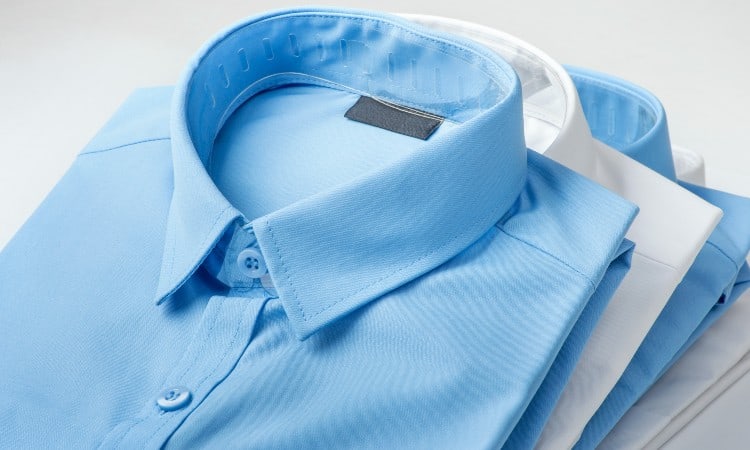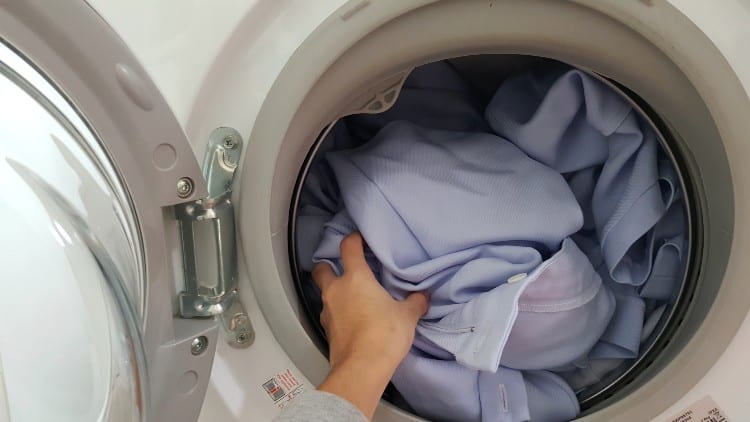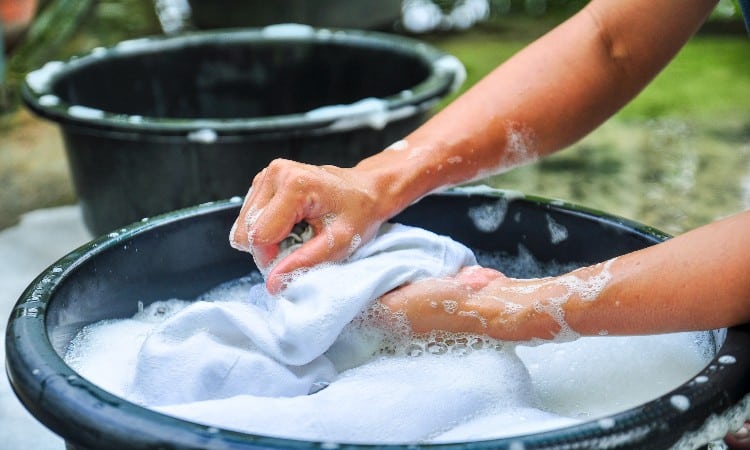If you have to wear a dress shirt every day, you want your shirts to stay in the best shape for as long as possible. But even if you only wear dress shirts occasionally, you still want to make sure you clean them the right way. So how do you wash dress shirts properly to keep them looking their best?
Most dress shirts can be washed in the washing machine, using the right methods and steps. This includes unbuttoning the shirt, using the delicate cycle, water temperature appropriate for the shirt’s color, and high-quality laundry detergent. Dress shirts made of more delicate materials may need to be hand-washed.
In this article, I’ll explain how to wash dress shirts properly. I’ll go over when to wash the shirt in the machine versus washing it by hand, including the steps and methods you should follow. I’ll also explain how often dress shirts require washing, how to dry them properly, and more.

Can You Wash Dress Shirts?
Dress shirts tend to look nicer than casual shirts and are often more expensive as well. Because of this, many people want to be careful to keep them in the best possible shape so that they don’t have to replace them as often. This includes not wanting to wash them or not knowing how to wash them properly.
But the good news is that you can wash dress shirts and don’t necessarily have to be cautious or nervous about doing so. You just have to make sure you use the right methods. It is perfectly safe to wash most dress shirts, especially those made of cotton or a cotton blend fabric.
That being said, there are some dress shirts that it isn’t a good idea to wash, especially those made from finer and more expensive fabrics. If that’s the case, there are other ways to clean them. But, in most cases, dress shirts can be washed safely. Just check the care tag beforehand to see what the recommended washing method is.
Should Dress Shirts Be Washed or Dry Cleaned?
Many people assume that dry cleaning is the safest way to clean dress shirts. While you certainly can, it’s not always necessary. Dry cleaning also isn’t the most convenient or economical way to clean dress shirts, especially if you have to wear one every day.
For dress shirts made with cotton or blended fabrics, as most of them are, it’s okay to wash them. This means using water and laundry detergent, similar to how you would wash any other type of clothing.
However, that doesn’t mean you should wash them the same way as other clothing. This is simply because you don’t want the dress shirt to shrink or lose its shape. The bottom line is that if the shirt is made from any type of cotton fabric, it is unnecessary to have it dry-cleaned.
Even if the shirts are made from silk or wool, they can still be washed. But you will want to do so even more carefully and wash them by hand, so many people prefer to have them dry cleaned.
If you’re still iffy about washing dress shirts yourself, another option is to have them professionally “washed and pressed.” Many laundry services offer this option, which isn’t the same as having the shirts dry cleaned. You’re essentially just paying a professional to wash them for you.
Can You Machine Wash Dress Shirts?
As long as the dress shirts are made of cotton or a cotton blend fabric, it is safe to put them in the washing machine. But as previously mentioned, that doesn’t mean you should wash them with or in the same way as your other clothes.
You will want to wash dress shirts slightly more carefully than your other clothes. This means taking the proper steps when washing them to prevent shrinking and damage. As you know, cotton is one of the fabric types that is the most prone to shrinking. But cotton can fade faster than other fabrics as well.
It’s best to wash cotton dress shirts in the washing machine on a delicate cycle. This will help prevent a lot of agitation and prevent damage to the shirt. You also want to use the right water temperature and detergent to prevent shrinking and help the shirts maintain their color for longer.
If you have dress shirts made of more delicate materials such as silk or wool, it’s best to hand-wash them. Even the delicate cycle can be too much for these fabrics, which are also prone to shrinking and damage. When in doubt, always check the care tag to see what fabric the shirt is made of and what the recommended washing method is.
Should You Wash Dress Shirts Buttoned or Unbuttoned?
Most dress shirts button up the front, as well as have sleeves and collars that button as well. That raises the question of whether you should wash dress shirts buttoned or unbuttoned. Does it make a difference?
It actually does. It’s much better to wash a dress shirt unbuttoned, especially in the washing machine. This is because washing a shirt while it’s buttoned can cause the button holes to stretch or lose their shape. The agitation of the washing machine can cause the threads around the buttonhole to loosen, especially with repeated washing over time.
How to Wash Dress Shirts at Home: Step-By-Step
If you don’t want to shell out money to have your dress shirts professionally cleaned, hopefully, you now know that most dress shirts can be washed in the washing machine at home. This is the preferred method and it is also the most economical.
Unless the dress shirts are made from delicate materials other than cotton, it is not necessary to hand-wash them at home. Hand-washing multiple dress shirts can be very time-consuming, so you may not want to go this route unless the dress shirts are made from wool or silk.
But I’ll provide the steps for washing dress shirts in the washing machine and hand-washing them. In either case, make sure to follow the proper steps. By doing so, you should have no problem keeping your dress shirts looking their best, no matter how often you wear them.
In the Washing Machine

Washing dress shirts in the washing machine is when you especially want to follow the proper steps. Here’s how to do it.
Prepare the Dress Shirt
The first thing you want to do is prepare the dress shirt to be washed. You can just throw the shirt in the washer like you would with t-shirts. Instead, you want to make sure all the buttons are unbuttoned, which includes buttons up the front and on the sleeve cuffs and collar.
Some dress shirts have built-in collar stays, designed to keep the collar sharp and in place. Others have removable collar stays. You can remove the collar stay before washing if it is removable. But if not, it’s okay to wash the shirt with the collar stay in place most of the time.
It’s also recommended that you turn dress shirts inside out before washing them. That way, any deodorant stains, body oils, lotions, and other products can be removed from the shirt more effectively.
Pre-Treat Stains
The next thing you’ll want to do is pre-treat any stains so that they’ll wash out. There are many ways to remove stains depending on the type of stain you’re dealing with. But, most commercial stain removers will remove stains easily and come in spray or liquid form.
When using stain removers on colored dress shirts, make sure to avoid any products that contain chlorine bleach. You don’t want to discolor the shirt when trying to remove a stain, which might result in a more permanent type of stain.
Use Proper Machine Settings
When washing your dress shirts, using the proper machine settings is the most important step. But first, it’s a good idea to only wash dress shirts by themselves or with other dress clothes.
Unless the shirt is heavily stained, it’s safest to use the delicate cycle for dress shirts. Some washing machines may call it the gentle cycle instead. But, both of these cycles use less agitation that could cause the shirt to lose shape or become damaged. If the shirt is heavily stained or the cotton is pre-shrunk, it’s okay to use the normal cycle if you use the right water temperature.
Using the right water temperature is important because water that is too hot can cause the colors of the shirt to fade and the shirt itself to shrink. The water temperature you use will depend on the color of the shirt. Generally, warm water is ideal for shirts that are white or light-colored. For darker colors, use cool or cold water to prevent fading. Avoid hot water entirely, which can cause shrinkage.
Use the Right Detergent
Make sure to use high-quality laundry detergent with dress shirts. If the shirts are colored, you may wish to use a laundry detergent that is designed for colored clothes. Avoid laundry detergents containing bleach as well.
You also want to make sure that you use the proper amount of laundry detergent. You don’t want detergent residue to build up in your dress shirts. This can be caused by using too much detergent and the detergent not getting rinsed out all the way.
Wash the Shirt
Now all that’s left to do is just let the washing machine run through the complete cycle. After the machine has finished, remove the shirt from the washing machine promptly to prevent wrinkles. Hang the shirt up or lay it flat to dry. While it is still a bit damp, you can iron it to remove any wrinkles that have formed and make it crisp.
Hand Wash

If your dress shirts are made of a delicate material such as wool or silk, it’s best to hand-wash them if you don’t want to have them dry-cleaned. Here’s how to do it.
Pre-Treat Stains
The first thing you should do is pre-treat any stains that are on the shirt. Many commercial stain removers are safe for delicate fabrics, or you can use products such as vinegar and baking soda, depending on the stain. Again, just make sure to avoid using stain removers that contain bleach, which can deteriorate delicate fabrics in addition to causing discoloration.
Fill a Tub with Water
Next, fill a washtub or sink with enough water to fully submerge the shirt. The water should be cool to lukewarm. If you’re only hand-washing one dress shirt, you only need about 1 teaspoon of detergent. You can add a tablespoon of detergent if you’re washing more than one shirt.
Let the Shirt Soak
Place the shirt in the water and let it soak for a few minutes. Then, gently swish the shirt around in the water to make sure that the detergent is distributed evenly. Be careful not to wring or twist the item, especially for delicate fibers, which can break easily.
Rinse the Shirt
Once you feel like the shirt has been cleaned thoroughly, rinse it. To do this, drain the soapy water and refill it with clean water. Gently swish the shirt until all the detergent has been removed. You can tell because fewer suds will be produced. Repeat draining and rinsing the water until the water is no longer soapy.
Let It Dry
After removing the shirt from the water, gently squeeze the excess water out. Do not wring the water out. If the shirt is made of silk, hang it up to dry out of direct sunlight. If the shirt is made of wool, lay it flat. Because wool is heavy when wet, hanging it up can cause the fabric to stretch.
How Often Should You Wash Dress Shirts?

Unless the shirts are stained or dirty, it’s not necessary to wash dress shirts after every wear. Washing clothing too frequently can shorten the life of the clothing. It’s okay to wash dress shirts every 2-3 wears, but you may need to press them in between each wear. In between wears, storing them by hanging them up in a cool area can reduce wrinkles and odors and keep the shirt in good shape if you aren’t planning on washing it.
However, if you wear a dress shirt only occasionally and aren’t planning on wearing it again for some time, it’s a good idea to go ahead and wash it before putting it away. You don’t want to leave deodorant and other product residue on the clothing for too long because it can cause stains and discoloration over time.
Can You Machine Dry Dress Shirts?
Although you can wash most dress shirts in the washing machine, the dryer is not the preferred way to dry a dress shirt. The heat from the dryer can cause shrinkage and damage to dress shirts. It’s better to hang the shirt or lay it flat to dry, then iron it while it is still damp.
However, if you’re in a hurry, you can dry the shirt in the dryer. If you use the dryer, you want to use a low-heat cycle to prevent shrinkage and damage. Remove the shirt while it is still damp so you can iron it if necessary.
Conclusion
Dress shirts don’t have to be professionally washed or dry cleaned. You can wash most of them at home, either by hand or in the washing machine. If you wash them in the washing machine, make sure you use the appropriate methods and settings to keep your shirts in the best possible condition. If you found this article helpful, share it with others and leave a comment if you wish. Thanks for reading!